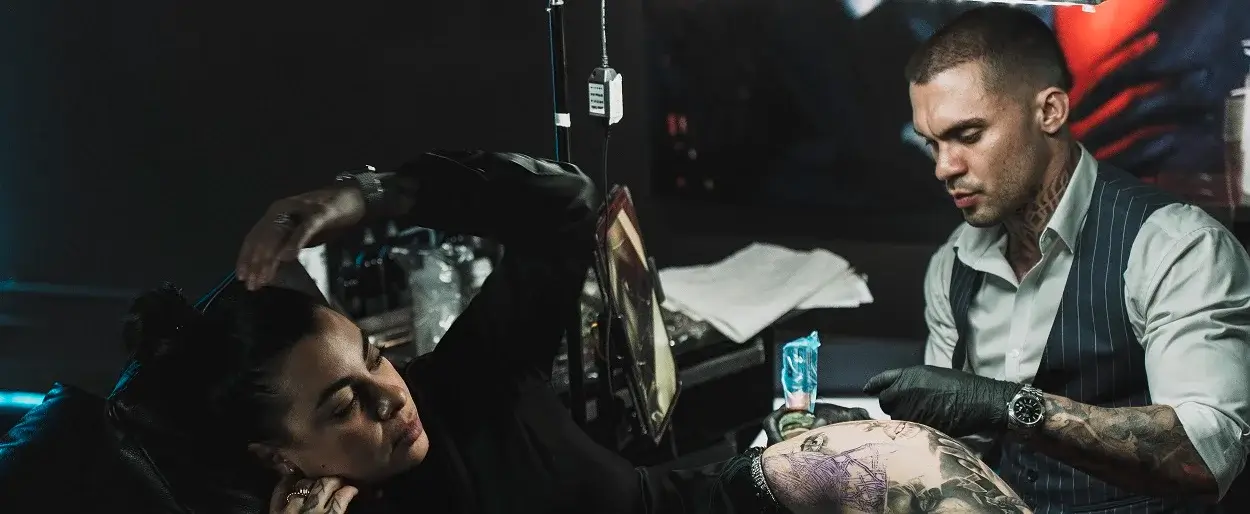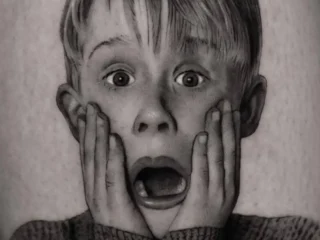Inked Mag Staff
May 10th, 2023
ARTIST SPOTLIGHT: JARIS INK
The Lithuanian tattoo artist creates stunning black-and-grey micro realism
If we had to put a label on Jaris’ work we’d go with “small and mighty.” The Lithuanian tattoo artist specializes in micro realistic black-and-grey, one of the most difficult styles to do well. But make no mistake, this graphic designer/tattoo artist is capable of moving seamlessly between different styles. We spoke with Jaris about how he found his way to micro realism, his love for Japanese art and much more.
Can you introduce yourself and tell us a little about who you are?
My name is Jaris, and I am a tattoo artist and graphic designer specializing in micro realism style tattoos. I am passionate about drawing and creating intricate designs that capture the essence of my client’s ideas. Through my work, I aim to bring their visions to life and create unique pieces of art they can proudly display on their skin. With my graphic design background, I can combine my technical skills with my artistic talent to create truly one-of-a-kind tattoos.
When did you first become interested in art?
I have loved art from a very young age. As far back as I can remember, I have always been drawn to drawing and creating. Even in kindergarten, my teachers would comment on the quality of my drawings and encourage me to sign them. When I was 8, my parents enrolled me in an art school, where I spent eight years honing my skills. While I was not always the most attentive student, I was always excited to create something new and express my creativity. In fact, in my later years of art school, I sometimes skipped classes or ran out to work on my own projects.
View this post on Instagram
How did you start tattooing? Did you have an apprenticeship?
Becoming a tattoo artist was never something I set out to do. In fact, at one point in my life, I had even considered leaving the art world altogether due to the belief that it would not provide a stable income. I pursued a different career path and became a personal trainer. However, one day, when I was 15, a friend asked me, “Do you know how they get tattooed in prison?” That’s what got me thinking about tattoos, and that’s when we got our first stick-and-poke tattoos, and he jokingly told me that if I got a tattoo machine, he would let me practice on him. After some hesitation and a few years, I eventually purchased a tattoo machine when I had some extra money.
As I began practicing, I was pretty good for a home tattooer, but I quickly hit a wall. Being a perfectionist, I realized there were technical difficulties I needed to overcome to improve my work. This led me to search for a tattoo shop where I could apprentice and learn the proper techniques and skills required to become a professional tattoo artist. During my apprenticeship, I fell in love with the art form and decided to make it my career.
View this post on Instagram
What is the tattoo scene like in Lithuania?
From my perspective as a tattoo artist in Lithuania, I would say that the tattoo scene is still developing in the country. Being a post-Soviet country, tattoos are not yet widely accepted in mainstream culture, and there are still many older people who associate tattoos with criminal activity.
That being said, there is a small but tight-knit community of tattoo artists and enthusiasts in Lithuania. We have one tattoo convention that normally occurs annually and the last time it was held was back in 2019. The convention is set to take place this summer, which is a positive sign that the tattooing scene is starting to gain more traction.
Overall, I believe that people in Lithuania are becoming more open to the idea of tattoos as a form of self-expression and art. However, there is still a long way to go before tattooing is widely accepted as an art form. At present, I feel that tattoos are viewed more as a service rather than an art form, but I hope that this perception will change as the tattoo scene continues to develop and evolve.
View this post on Instagram
How did you come to find your current style? What drew you to black-and-grey realism?
When I first started tattooing, I was drawn to the neo-traditional style and wanted to specialize in that area. However, it was during my studies in the art academy that I discovered my talent for hyper-realistic drawing. When I was studying graphic design at the Academy of Art, I had a strange experience during one of my semi-annual exams. I had to create five hyper-realistic drawings in order to render them as close as possible to reference images.
After completing the assignment and submitting my work for evaluation, I was surprised to receive a call from the lecturers. Upon arrival, I quickly noticed that one of my works looked strange. The lecturer, holding an eraser in his hand, immediately started to erase the drawing, which caused me great shock and horror.
“Why doesn’t it rub off?” he asked, puzzled. “Because I used graphite sealant,” I explained. I was using graphite sealant to protect my drawings from smudging, so this explained why he hadn’t removed the graphite with an eraser. The lecturer, understandably skeptical, asked me to prove my process.
Despite the fact that I had put a lot of time and effort into creating a work of art, I was in danger of having it rejected as a print with a painted overlay. It took me half an hour to explain and demonstrate my method, using progress photos to help illustrate the process.
In the end, this situation became a great story and an even greater compliment. Although I initially felt angry and frustrated by the teacher’s skepticism, the experience strengthened my confidence in my own abilities and my unique approach to creating hyper-realistic artwork.
That’s what got me thinking that I may be good at this, so one day I showed my hyper-realistic drawing to my mentor, who suggested that I try this style on the skin. I was intrigued by the idea and started experimenting with black-and-grey realism in my tattoos. I found that this style allowed me to create incredibly detailed and intricate designs, and I quickly fell in love with it.
I believe that my perfectionistic tendencies have played a big role in my success with black-and-grey realism.
View this post on Instagram
What is the most difficult aspect of working in realism?
In my experience, the most difficult aspect of working in realism is to achieve the accuracy and detail needed to create a truly realistic image. It requires great skill and attention to detail, as well as a deep understanding of how light and shadow interact with different textures and surfaces.
When it comes to micro-realism, the challenges are even greater. It is important to work with the skin with precision and delicacy, while at the same time remembering not to overload it. This can be tricky because the skin can only hold a certain amount of ink in one place, and overworking the skin can cause the ink to bleed out during the healing process. In addition to precision and subtlety, contrast is also very important. This means carefully balancing light and dark areas of the design to create the illusion of depth and dimension.
What are some tattoo motifs you’ll never get sick of doing?
Definitely small realistic butterflies and small realistic animals in general, I think that’s my favorite thing to tattoo.
View this post on Instagram
In addition to doing realism, you also seem to do a lot of Japanese-inspired pieces. Can you tell us a little about the attraction to this kind of art? How does the artistic process differ from when you’re working in realism?
You are right, I like not only realistic works but also Japanese-inspired works. This type of art appeals because of the beauty and depth of the traditional Japanese style. The artistic process differs from realism in several respects. In realism, I have to focus on achieving a high level of detail and precision, whereas in Japanese-inspired works I can be more expressive and creative. Japanese-inspired works also tend to be on a larger scale, which allows more room for different techniques such as shading, line work and color mixing.
Apart from the technical differences, Japanese-inspired works have a deeper cultural meaning that I find very inspiring. Many traditional Japanese tattoos have a story or meaning, for example, they symbolize a particular deity or a particular life event. In general, I am attracted to Japanese-inspired tattoos that combine artistic expression and cultural meaning. Although the artistic process is different from working in realism, I find both styles rewarding and fulfilling in their own way.
View this post on Instagram
Have you ever considered working in color? Do you see yourself doing so in the future?
Yes, I have considered working in color and have even tried to do so several times. However, I feel that I still need more experience before I really master the art of color tattooing. In the future, I would like to add neo-Japanese style tattoos to my portfolio.
How do you find your references? Do you take your own photos?
When looking for tattoo references, I usually look for legal and unused images that I can use for my work. Although I would love to take my own photos for each tattoo, this is not always possible or practical. For example, if a client wants a lion tattoo, it is not possible for me to go on a safari and take photos, so I have to use the sources available to me. 😛
View this post on Instagram
Where do you see your art going in the future? Do you work in any mediums other than tattooing?
Apart from tattooing, I also love to draw and would like to have another exhibition of my works on paper one day. I also enjoy design and illustration and have done some work in this field, for example, designing for a basketball club in Lithuania. So I plan to continue exploring different media and finding new ways to express my creativity.
What do you think you’d be doing if you weren’t a tattoo artist?
If I wasn’t a tattoo artist, I would probably be pursuing other paths. I am a certified personal trainer, but I also have a passion for design and using my creative abilities in business. I would like to explore ways to reach more people with my art, perhaps through a clothing company or a similar venture.
If you want to know more about Jaris and find out how to book a tattoo with him, visit his website by clicking here.
View this post on Instagram
View this post on Instagram
View this post on Instagram
Editor's Picks
Bridging Classical Art and Modern Tattooing
Esteban Rodriguez brings the discipline of classical fine art to the living canvas of skin, creating hyper-realistic tattoos that merge technical mastery with emotional depth.
Show Your Ink Fashions Brings Custom Style to Tattoo Culture
Show Your Ink Fashions creates custom shirts designed to showcase your tattoos as wearable art, blending fashion with personal expression.
The Ultimate “Superman” Tattoo Roundup: Just in Time for Superman’s Return to Screens
With Superman’s big return to theaters, fans are revisiting some of the most iconic ink inspired by the Man of Steel.














